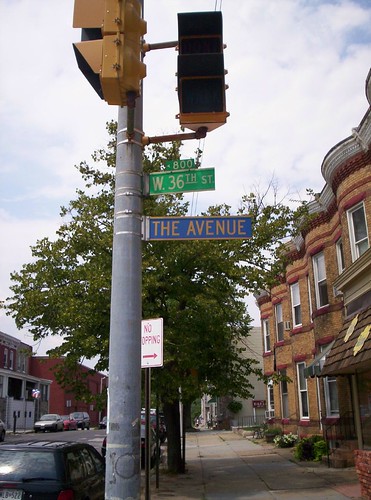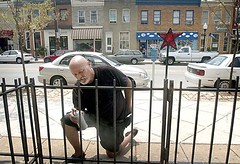Does change mean gentrification? Categorically?
 The Avenue, in Hampden, Baltimore.
The Avenue, in Hampden, Baltimore.Today's Baltimore Sun has the article "Hampden in throes of change: Old-timers and newcomers agree they don't want gentrification to dilute the neighborhood's appeal." It reminds me of a couple conversations I had this past weekend. The first involved someone describing a trip to Baltimore and he described Fells Point as the kind of place you can buy antiques, or towels, shower curtains, and groceries. In the second conversation, one of the people described the change on 8th Street SE (Barracks Row) as "gentrification." He wasn't using the term pejoratively, just using it to describe the change. OTOH, I would have called this investment in neighborhood improvement and change.
Does change have to mean gentrification, which people often use to mean displacement? One of the things that does bother me about "successful" commercial districts is that they often end up focusing on discretionary goods like furniture and antiques, and not on practical, daily necessities. For example, dollar stores end up being the major provider of housewares and the like in urban commercial districts.
The big thing this comes down to is the cost of commercial rents. The article in the Sun doesn't say what the prevailing rents are in Hampden. I can't expect that they are greater than $20/s.f., except for the Royal Farms (like a 7-11 but with seating) and the bank, which are relatively new buildings. Nonetheless, there is a fair amount of vacant space (I didn't count) although I wouldn't categorize any of the properties as marginal, unlike say H Street NE, or elsewhere in the city. Virtually all the commercial properties appeared to be in "ready-to-move-in" condition (albeit with some cleaning and painting). None appeared to require serious renovation.
Are businesses always viable and should they be retained, even if they don't generate much revenue?
Blog entries relevant to this are "(Why aren't people) Learning from Jane Jacobs" and "More about Contested Space--"Gentrification". Click here for Hampden Main Street in Baltimore.
 Tom Ensor, born and reared in Hampden, is a retired state maintenance worker who fabricates iron art work and fences. He said he is pleased with the changes occurring in Hampden. Here he paints a fence he made for the 2 Hot Art Chicks gallery. (Baltimore Sun photo by Kenneth K. Lam)
Tom Ensor, born and reared in Hampden, is a retired state maintenance worker who fabricates iron art work and fences. He said he is pleased with the changes occurring in Hampden. Here he paints a fence he made for the 2 Hot Art Chicks gallery. (Baltimore Sun photo by Kenneth K. Lam)



0 Comments:
Post a Comment
<< Home